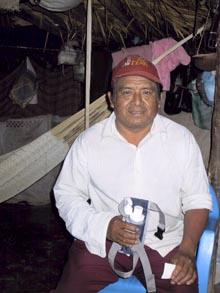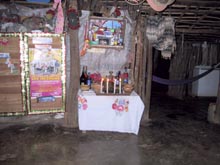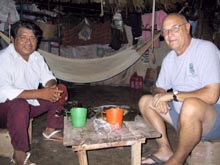
Night fell and it got dark with tropical quickness just as I was dropped off in a real VW bug at the bone-setter/massage man’s home. On my way inside I almost stepped on a tarantula that seemed as big as my flip-flop. A quick two-step and the spider and I did not meet. Grace Bascope, a professor of anthropology at TCU and the program leader for two weeks of an anthropological field school with Maya Research Program, introduced me to the dueña, the lady of the house. The dueña said that there was a novena (a prayer service for the departed father and mother of the home owner) going on at that moment but that I was invited to enter and watch until it was over. So I followed her back into the darkness, walking on a flat sidewalk that changed into a rough path, almost completely unlighted. Ahead was light! A traditional Yucatecan Maya stick hut with a thatched roof was to my right and an open space with a long table to my left. I ducked as I entered the hut. At the far end was the kitchen; three large blackened rocks, set directly on the floor, marked the cooking area. No refrigerator, no cabinets, no sink or running water, no counters or countertops. A bare 60-watt bulb hung by a lamp cord from one of the wooden crossbeam poles that helped tie the structure together illuminated all of this.
We ducked again and entered a second structure abutting the first. A plastic chair was brought out for me to sit in as I looked around. Directly across from me was a passageway to a third structure; it was dark. To my right, a man was lying in a hammock suspended from the crossbeams. He greeted me with a smile. To the left of the dark opening, two women dressed in traditional huipiles (colorfully-embroidered white shifts) were seated with their backs to me. They were facing a makeshift altar set up on a small table. The women were alternately singing and chanting, one of them leading, as they followed the hand-written ritual in a spiral-bound notebook. The altar centerpiece was a small, freestanding wooden cross with something resembling a huipil draped over it. At the front of the altar, a series of small candles were burning, illuminating a small photograph in the center and four bowls placed to the sides. The women sang without accompaniment. I sometimes recognized a few words like “Padre, filos y espiriti sante” and then got lost again as the petition continued, seeming to swing in and out of Spanish, Latin and Yucatec Mayan. People were chatting behind me as they looked in to see the white stranger sitting in their house. The women finished, turned and smiled at me and moved their chairs to the sides of the room. The dueña introduced me to Don Estavo, her husband, the bone-setter and massage giver. He smiled again, shook my hand and returned to his hammock, this time sitting in it rather than lying down. As the dueña cleared the altar, I asked what was in the bowls. She replied that they were filled with chocolate and asked if I would like some. I said yes.
I then realized it was all on me. I had been waiting for this moment for some months. My Spanish gets me by in most situations, but it is very far from fluent. Fortunately my host, hostess and all of the other inhabitants of the house were in the same boat. They also “just got by” in Spanish, but were far from fluent in it because in their daily lives they spoke Yucatec Maya, one of the twenty-four living Maya languages. So we both struggled a bit with communication. I asked Estavo about his massage practice, how long he had been doing it, and how he learned it. He told me that he sometimes goes to the client’s house; sometimes the client comes to his. He also said that he had been practicing for 14 years and is self-taught. I told him a little about my practice in New Jersey, leaving out the concept of a professional office, since that would not make any sense to someone whose life was not too much different than his ancestors of a thousand years ago. The light bulb is new, as is the small television. Other than those additions, his ancestors would have been quite at home here.
 Then his wife brought in a small, low wooden table. Two low stools were placed across from each other and I was invited to the table. Don Estavo took the stool across from me. The dueña brought a plastic bucket filled with water for us to wash our hands in. A bundle of banana-leaf wrapped tamales were served directly on the table along with two large cups of chocolate. The large rectangular tamales were filled with tender corn meal, chicken and sauce – very tasty and very different from the cornhusk-wrapped tamales most of us think of. The chocolate was almost room temperature and not as rich as a cup of cocoa or hot chocolate, but delicious nonetheless. I presented Don Estavo with a pump bottle of Biotone Massage Oil along with a belt and bottle-holster. He was very pleased with the gift.
Then his wife brought in a small, low wooden table. Two low stools were placed across from each other and I was invited to the table. Don Estavo took the stool across from me. The dueña brought a plastic bucket filled with water for us to wash our hands in. A bundle of banana-leaf wrapped tamales were served directly on the table along with two large cups of chocolate. The large rectangular tamales were filled with tender corn meal, chicken and sauce – very tasty and very different from the cornhusk-wrapped tamales most of us think of. The chocolate was almost room temperature and not as rich as a cup of cocoa or hot chocolate, but delicious nonetheless. I presented Don Estavo with a pump bottle of Biotone Massage Oil along with a belt and bottle-holster. He was very pleased with the gift.
And then we got down to business: the massage exchange. The idea was for me to experience and learn some Maya massage and then to reciprocate and give/teach a traditional Western massage. Don Estavo asked if there was anything that needed work. I replied that over two years ago I had dislocated my foot in a motor scooter accident and that my ankle was still swollen, sometimes painful, and lacked flexibility. He sat me in a hammock and took my lower leg into his hands as he seated himself on one of the low stools. He then proceeded to work every muscle, tendon and ligament in my foot, ankle and lower leg. He used just the strength of his fingers, hands and forearms. He was strong! A lifetime of working in the milpas (the traditional corn fields of the Maya) coupled with his “extra-job” delivering massages and bone setting had made his hands and forearms like steel. He hurt me so much that I wanted to cry out. I wanted him to stop. I lay back in the hammock and tried not to pull my leg away from him. Why was I subjecting myself to this pain? Because I could feel him loosening the muscles, stretching the tendons and breaking up adhesions that had been there for more than two years. I could feel my foot move more freely than it had for two years. It became a tug-of-war between my pain receptors and my propriceptors. Pull away from the pain or accept it? I accepted it.

I knew that my hands and forearms alone would never be strong enough to do what he was doing to my ankle. But I recognized that being in the hammock while being massaged allowed me to rhythmically move into the pain and then swing away from it, move into it and then away from it. And I realized this rhythm of more pressure/less pressure could be applied to almost any of the massage techniques that I already knew. Using a hammock in place of a massage table would provide the means to deliver rhythmic, rocking, ever-changing pressure, ever-changing stretches… changes that already exist in many of the massage techniques that I currently use; techniques like Thai-Yoga massage, Trager, sports massage, Trigger Point, and even traditional Swedish massage.
After what seemed like hours of pain, Don Estavo indicated he was finished with me. Now it was his turn to receive and learn. What could I teach him that he did not already know? I asked him if he had ever had a face, scalp and neck massage and when he said no, I had him lie face up in the hammock. I stood near his head and proceeded to give him the same face, scalp and neck massage that I give to all my clients, working all the major muscles of the face, neck and head, working certain tsubos, working the “third eye,” exchanging energies, changing perceived atmospheric pressures through the ears, stretching and pulling face, neck and head muscles… and all the while, changing my pressure as the hammock gently rocked from side to side. This was a different massage than Don Estavo had ever had before. It was not therapeutic in the sense that all his massages are therapeutic. All his massages are strictly physical. All his massages are intended to “fix” a muscle problem (and in the case of his bone-setting skills, to “fix” or reduce a fracture). The massage I gave him was to just make him feel better, physically, mentally and spiritually. And it did.
I left with both of us feeling as if we had a good and fair exchange. And as soon as I returned to New Jersey, I hung a traditional Yucatecan hammock in one of my treatment rooms so that I could offer Maya Hammock Massage.
First published in Inner Realm, the ultimate adventure, a magazine dedicated to your personal journey. It is published monthly and distributed in northern New Jersey.
